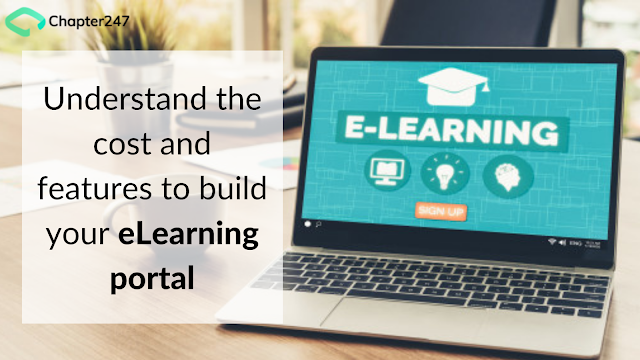Understand the cost and features to build your eLearning portal
This is a valid question, every Learning organization should ask before intending to either create their own LMS or refurbish what they already have. The eLearning market has grown at a whopping rate of 900% since 2000 and since then there is no looking back. The pandemic has fuelled the pace of LMS growth even further and it is expected that the global markets touch $300 billion by 2025 in a report by Global Insights. Schools and universities have embraced the idea but even corporates have turned to LMS for employee training.
Over the years the meaning of LMS has changed with newer features becoming an important part of the application. Not just that, it is not only about learning, but also the holistic experience that counts and this is where trending technologies come into play.
Source: Binus University
The above graph clearly shows that Asian countries are ruling the charts with the highest adoption rates. This could be because the developed countries have already established systems of Learning web applications along with the traditional course as a part of their pedagogy. To build one requires having the most important features which your eLearning portal must-have and through this feature, we also will provide a cost estimation to get started with your Learning ePortal development.
Must-have features of ePortall development
Online admission process
Having an online admission process is the first key step towards establishing sound economics of eLearning. When the students enroll in the course, they will be routed towards logging into an LMS enabling their admission process and making online admission an essential feature in the eLearning portal website. By logging in students gain access to materials, audio and video lectures, etc. Students can also take part in discussions, send emails or even messages to instructors and classmates. Having an online admission process implies
Smooth application process with less paperwork
User-friendly interface enabling better learning experience
Real-time performance reports customized to every student
Assessment and feedback
Having tests, assignments and quizzes will go a long way in ensuring that the student completes the course and the instructors can evaluate the progress of students individually. With planned assessments, a student can also revise and get extra practice which will help them score better in actual exams. Instructors and management will understand the learning path of students and with analytics in the picture, they will also understand if the students need a revision of a tough course module. Although learning in a virtual environment may disconnect a student from others, features like live feedback and video sessions will go a long way in filling the gap and help in the success of the course. Gradebooks will help in feedback management. Instructors, with the help of performance metrics and the following data, will help them to provide the necessary help whenever needed. Digital backpack will allow teachers to learn more about the students right from the start of the course.
SIS management
Student Information Management Systems (SIMS) is one of the most important features that is responsible for record upkeep. It helps in completing several functions like record-keeping of regular work and tests, performance appraisal, and attendance. SIMS enables you to access the student record and is important in many ways:
Data sources and processes can be easily integrated with a single function
With heightened security measures, student data and privacy is protected ensuring the integrity of data
When information is sourced centrally, it will also lead to centralized provisioning, billing, and accounting.
Customized reports of student performance also can be generated real-time
Ready accessibility to update student information.
Mobility
M-learning or mobile learning has become an essential element in eLearning applications because for a student, flexibility counts. They prefer to study from anywhere which is why mobility has to be a part. 57% of the users believe that a business that has a poorly designed mobile site is less likely to succeed in the long-run. This trend has sure been on the rise because learners believe that learning enhances mobile learning devices. Mobile App-based learning also has found many takers making the entire process customized and easily accessible.
Community and social engagement
Online education focuses on individual learning which can be detrimental to students because they could feel a sense of disconnect with fellow students. When the student learning web application is connected with a community, it will help students engage with each other, expand their learning territory, and also provide them with the necessary exposure. Several social engagement tools can help students to get instant feedback. Social media offers an important spot for peer connection, discussion enabling students to discuss their courses, questions, and even collaborate for any assignment.
Reporting and data analytics
Elearning is much more than learning and teaching. It should result in better performance of students with every passing day and the reporting and analytics feature will go a long way in ensuring that. Analytics helps the instructors in understanding how each student is performing module wise. When data tracking has been schematically designed the reporting process will help in monitoring every student’s performance allowing tutors to change the course of teaching for better results. For future course planning, such data will help eLearning organizations to get information related to popular courses, student flagging, and less popular courses. So, all-in-all, this feature will help teachers understand the productivity of the course and can keep track of student progress on an ongoing basis. Some of the crucial metrics to be considered are:
Time spent to complete the course
Number of times student has exited the page
Satisfaction ratings from the parents
Learner Progress
Learning style and preferences for learning
Costs of building a portal for your Elearning project
To restrict the cost of eLearning portal development in one go would not be possible because the costs would ultimately depend on the features that you want to include.
Directly proportional to content elements
The higher the content quantity in your website, the greater will be the cost. But since this is a portal for learning, the cost has to go high. We are an experienced eLearning development solutions provider which recommends mixing different types of costs to balance costs. Learning styles have also undergone huge transformations because students need visual engagement to remain hooked on the content improving retention and interest in the content. Hence to decide the content element, it has to be first decided which style you are looking at:
Narrative style - content in the story-telling method with self-assessment questions
Procedural style - Mainly for training systems and calls for breakage of content into several logical steps.
Experiential style - More of multimedia because this style of content and self-discovery
Costs of the three styles
LEVEL OF INTERACTIVITY AND INSTRUCTIONAL DESIGN
Once the content design has been decided on then the next step is to understand the level of interaction and instructional design. The list is given below:
Dynamic media
Instructional design
High level of interaction within the portal
Customized graphics interface
Gamification
The estimated cost is $170 to $200 per hour
Conclusion
To build your eLearning portal, it is essential to plan your features and ring in an Elearning solutions provider because mid-way if the project is called-off it will increase your costs and could possibly reduce quality. Remember it is always important to go with experts because you have invested in it and every penny counts.




Comments
Post a Comment